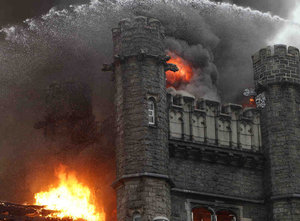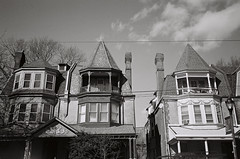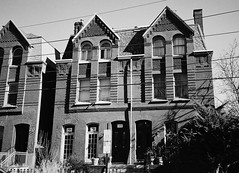Written and drawn by Ben Leech

Unlisted is a series of portraits highlighting unique Philadelphia buildings not yet listed on the Philadelphia Register of Historic Places. To learn how to protect a building by nominating it to the Register, click here.
Address: 1525 Chestnut Street
Architect: Simon & Bassett
Built: 1916

This edition of Unlisted will linger a while on the 1500 block of Chestnut Street, stopping to admire the incomparable Pomerantz Building standing guard across the street from last month’s Kresge Building. The first thing that jumps out at you, quite literally, is its cornice, a terra cotta riot perched so far out over the sidewalk that even the most chronic shoe-gazing pedestrians can occasionally be seen glancing up nervously as they pass beneath it.
But while the cornice grabs all the attention, the building is just as interesting underneath that fancy cap. Ignore all the ornate swishes, swoops and swirls for a moment, and you’ll be struck by just how modern the rest of the building looks, especially for something built in 1916. Virtually every other tall building in the city built before World War II features some variation of a punched window: individual openings set into a surrounding cladding material, usually masonry. Here, the windows are arranged as if the building’s two slender stone columns and single cross-beam are standing in front of an otherwise unbroken, five-story glass curtain wall. Instead of masonry or metal spandrels separating the individual floors, the Pomerantz Building features continuous vertical ribbons spanning multiple stories. I can’t think of anything else in the city with spandrel glass this old. For perspective, the building generally considered to be the world’s first commercial glass curtain wall, San Francisco’s Hallidie Building, was built two years later.
Also rare is its great collection of vestigal signage– three signs from three eras in three different styles, all advertising the same office furniture and supply company that constructed the building and remained its tenant for almost 90 years (the company is still in business elsewhere, now owned by former Phillie outfielder Garry Maddox). Up top, we’ve got the precisely engraved stone entablature. Down below, the plastic fantastic Eisenhower-era blue curlicue storefront sign. Around the side, a fading ghost sign in a boxy 1980s font.
The building has been vacant since a planned condo conversion stalled out in 2006, and I doubt all of this signage will survive if and when its redevelopment gets back on track. Hopefully the cornice has better prospects, but without the protection of historic designation, even its future looks tenuous. Gravity is a powerful force, and so is value engineering.


















